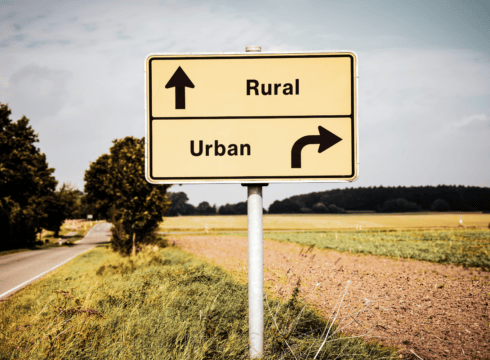According to the NSSO data, only 24% of rural Indian households have access to the Internet, compared to a 66% penetration in cities
The growing rural teledensity, which currently stands at 59%, provides a foundational infrastructure to advance inclusion efforts.
Bridging the urban-rural digital divide in India is not just a challenge; it is an opportunity to unlock the country's true potential
Inc42 Daily Brief
Stay Ahead With Daily News & Analysis on India’s Tech & Startup Economy
India’s rapid urbanisation and technological transformation have led to a thriving startup ecosystem in metropolitan hubs. However, as a venture capital investor actively involved in the Indian market, I believe that bridging the rural-urban digital divide is crucial for fostering an inclusive innovation landscape and a robust knowledge economy.
The Widening Gap
Despite the progress made in urban areas, the digital divide between rural and urban India remains stark. According to the latest National Sample Survey Office (NSSO) data, only 24% of rural Indian households have access to the internet, compared to a 66% penetration in cities.
Furthermore, 14% of rural citizens actively use the Internet, in contrast to 59% of urban adoption. This disparity stems from various factors, including patchy network coverage, affordability issues, and a lack of localised vernacular internet content.
The rural disconnect has severe implications for access to entitlements and opportunities. For instance, only 27% of beneficiaries under the Pradhan Mantri Kisan Samman Nidhi (PM Kisan) scheme receive Direct Benefit Transfer (DBT) payments digitally, highlighting the gaps in financial inclusion.
Moreover, as recruitment processes increasingly shift online, with applications and remote assessments going digital, internet literacy has become a crucial determinant of employment prospects.
Government Initiatives And Infrastructure Development
While the challenges are significant, I am optimistic about the progress being made through government initiatives and infrastructure development. The establishment of Common Service Center networks has been a game-changer, enabling the delivery of e-governance services through offline internet access.
Additionally, the growing rural teledensity, which currently stands at 59%, provides a foundational infrastructure to advance inclusion efforts.
One of the most transformative moments in India’s digital journey was the launch of Reliance Jio in 2016. Jio’s disruptive entry into the telecom market, with its affordable data plans and widespread coverage, has played a pivotal role in increasing internet accessibility across the country, particularly in rural areas.
Furthermore, the Pradhan Mantri Jan Dhan Yojana, launched in 2014, has significantly expanded financial inclusion by providing bank accounts to millions of previously unbanked individuals in rural India.
The government’s BharatNet project aims to provide high-speed broadband connectivity to village panchayats, serving the digital infrastructure needs of rural citizens and institutions. Moreover, the Budget 2022-23 proposal to develop digital villages that offer paperless citizen services across healthcare, livelihoods, and DBT payments is a step in the right direction.
Startups Leading the Charge
While government initiatives lay the groundwork, I am excited about the innovative solutions being developed by startups to bridge the rural digital gap. Vernacular knowledge platforms like Vokal, Khabri, and Niki.ai are spearheading access to voice-based search and content across various domains, catering to the language diversity of rural India.
In the realm of digital skilling, startups such as Avantis and Skillveri are leveraging Augmented Reality (AR) and Virtual Reality (VR) technologies to impart job-linked vocational skills training to rural youth within their villages, overcoming geographic constraints. These skill tech innovations have the potential to unlock new livelihood opportunities and bridge the urban-rural skill gap.
Ecommerce platforms like ShopKirana are enabling small rural retailers to order inventory via WhatsApp. At the same time, student-led hyperlocal delivery networks provide an inclusive pathway for rural entrepreneurs to participate in the digital economy.
Decentralised information hubs, exemplified by initiatives like TARAhaat, are empowering rural citizens with solar-powered digital centres that deliver e-services, distance education, and satellite-connected internet access while creating micro-entrepreneurship opportunities.
The Way Forward
As a venture capital investor, I believe that the key to sustainably bridging the urban-rural divide lies in a multi-stakeholder approach that combines affordable infrastructure, assistance mechanisms, and entrepreneur-driven information hubs tailored to the unique needs of Indian villages.
Replicating the successful model of Common Service Centers, with the establishment of solar-charged Rural Digital Centers operated by local village youth, can drive large-scale quality internet adoption. These centres can serve as hubs for delivering government and private e-services, providing digital literacy training, and fostering entrepreneurship.
To support these efforts, the pan-India fiberisation of all six lakh villages in mission mode is essential. This infrastructure blueprint will lay the foundation for a digitally equal India, bridging the rural-urban gulf and unlocking the potential of the country’s vast rural talent pool.
India is the world’s youngest and most populous country already, with a growing working-age population, predominantly in rural regions. Connecting this 21st-century talent pool with dignified digital livelihoods is not only an economic imperative but also a moral one.
An innovation-led, decentralised, and inclusive Rural Inclusion Mission, combining affordable infrastructure, assistance mechanisms, and entrepreneur-driven information hubs, can herald a digital economy that truly empowers all Indians, regardless of their geographic location.
Bridging the urban-rural digital divide in India is not just a challenge; it is an opportunity to unlock the country’s true potential. By harnessing the power of innovation, collaboration, and inclusive policies, we can create a digitally equal India that empowers its citizens, fosters entrepreneurship, and drives sustainable economic growth. I am excited to be a part of this transformative journey, supporting the startups and initiatives that are at the forefront of bridging the divide and shaping India’s digital future.
Key Highlights
Funding Highlights
Investment Highlights
Acquisition Highlights
Financial Highlights
Note: We at Inc42 take our ethics very seriously. More information about it can be found here.






